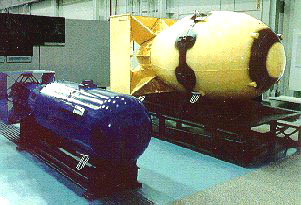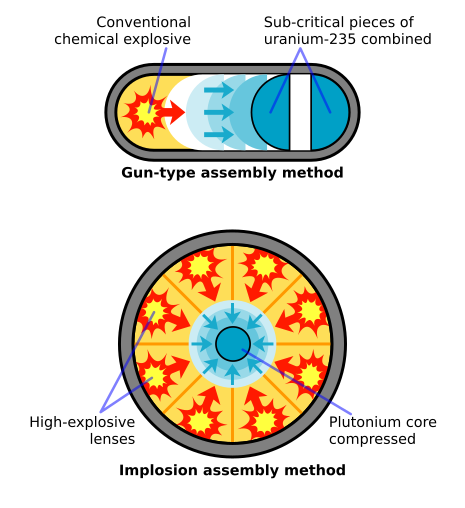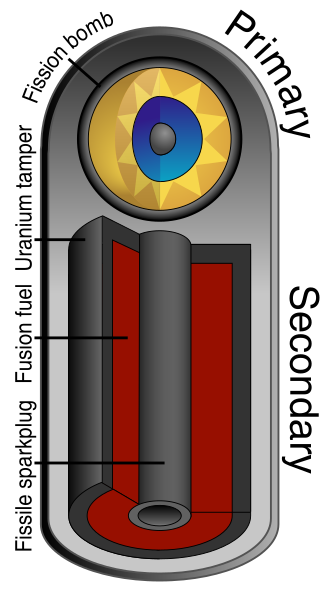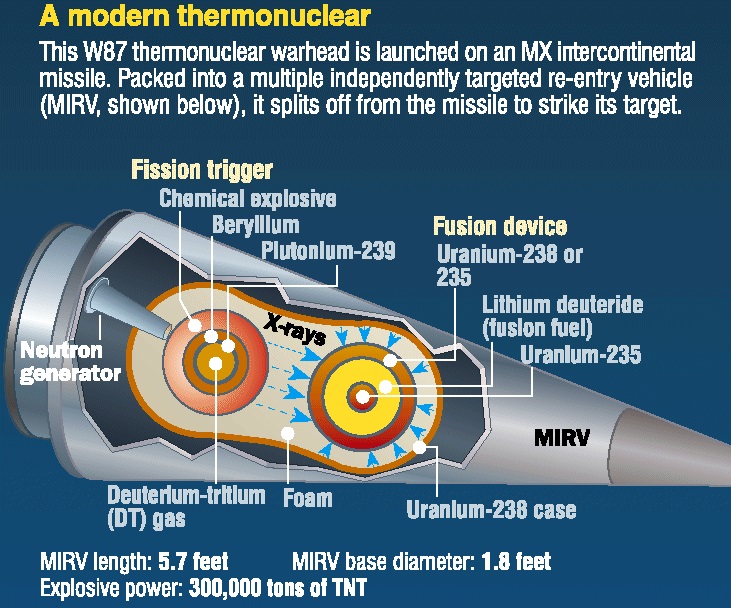Risks → War → Nuclear War → Nuclear Weapons
"I am become Death, the destroyer of worlds" Bhagavad Gita. This verse, from the Bhagavad Gita, was reportedly quoted by J Robert Oppenheimer after the successful detonation of the world's first atomic bomb (Trinity test, Manhatton Project, July 16, 1945, yield 25 kilotons of TNT).

The world's first nuclear weapons (1945) - Little Boy (yield 16 kilotons TNT) and Fat Man (yield 24 kilotons TNT)
Source: Nuclear Weapons Archive
Main classes of nuclear weapons
Nuclear weapons are essentially of two basic classes, viz., pure fission (also known as A-bombs) or combined fission/fusion (Thermonuclear, Hydrogen or H-bombs).
1. Pure Fission Weapons - These are weapons that only use fission reactions as a source of energy i.e., by assembling a subcritical mass of fissile material (such as plutonium or enriched uranium) into one that is highly supercritical. The first nuclear bombs were of this type viz., Gadget (the first atomic bomb detonated at the Trinity test, Los Alamos, July 16 1945), Little Boy (dropped over Hiroshima, 6 August, 1945) and Fat Man (dropped over Nagasaki, 9 August, 1945). Pure fission weapons are limited in explosive strength because of the difficulty of maintaining a subcritical mass prior to detonation. Their large size and weight also means that they are only deliverable as aircraft carried bombs.

Schematic of a simple fission only warhead
A mass of fissile material (enriched uranium or plutonium)
is forced to supercriticality allowing an explosive chain reaction,
either by
shooting one piece of sub-critical material into another (the gun method)
or by compression, using chemically fuelled explosive lenses (implosion
assembly method)
Source: Wikipedia
2. Combined Fission/Fusion Weapons - These are more efficient nuclear weapons which combine both fission and fusion reactions to enhance their
destructive power.
The concept of a "super" fission/fusion bomb was first proposed by Enrico Fermi and Edward Teller (a member of the original
Manhattan project under Robert Oppenheimer) as early as 1941 but failed to become a reality until 1951, when the mathematician Stanislaw Marcin Ulam,
developed a workable design for the fission/fusion interation called "staged implosion" which effective compressed
the fusion fuel before igniting it. Teller had originally thought that heat generated from the fission component, would be sufficient
to initiate a fusion reaction but that proved impossible. It was not untill the Ulam design that focued on staged radiation implosion, that a workable
bomb could be designed and constructed.

Schematic of a simple fission/fusion warhead (Teller-Ulam design)
A fission bomb uses radiation to compress and then heat a separate section of fusion fuel.
Source: Wikipedia
In Boosted Fission Weapons, fusion components allow the fission yield to be significantly boosted. For example, introducing a few grams of a
deuterium/tritium gas
to a pure fissile core will produce a burst of high energy neutrons and significantly increase yield.
In more complex Multi-staged Fission/Fusion Weapons (fission/fusion, fission/fusion/fusion or fission/fusion/fission)
X-rays/radiation from the primary explosive stage are used to compress a secondary stage (as in the Teller-Ulam design) then
the energy produced by the fusion second stage, is then used to ignite an even larger fission or fusion third stage.
Multiple staging thus allows the creation of bombs of virtually unlimited yield.
Combined staged Fission/Fusion weapons, as well as their higher yields have several other advantages. Firstly, they can
utilise fusion reactions involving isotopes of light elements such as hydrogen or lithium. They can also reduce weapon cost by reducing the amount of
costly uranium or plutonium required for a given yield, and can, most importantly, reduce the size and weight of the device.
This means that a bomb, with a yield of say 300 or 450 kilotons, can be quite small so that multiple independently targeted warheads (MIRVs) can be delivered
by a single ballistic missile such as with Trident or Minuteman III.

Schematic of the modern day fission/fusion W87 thermonuclear warhead
Boosted fission trigger then a fusion secondary stage. Note its small size.
Source: Nuclear Weapons Archive